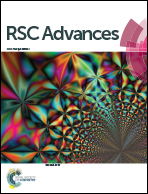A high performance electrochemical biosensor based on Cu2O–carbon dots for selective and sensitive determination of dopamine in human serum
Abstract
A green and facile method was developed by synthesizing a cuprous oxide–carbon dots/Nafion (Cu2O–CDs/NF) composite film for highly sensitive and reliable determination of dopamine (DA). The Cu2O nanoparticles could improve the conductivity of the electrode, while the CDs with carboxyl groups and the NF with sulfo groups could attract cations via the ion-exchange model and exclude anions by the electrostatic action. The proposed biosensor exhibited a low detection limit of 1.1 nM with a wide linear range of 0.05–45.0 μM and acquired excellent sensitivity and selectivity for DA. Furthermore, the Cu2O–CDs/NF/GCE also was applied to determine DA in human serum with satisfactory results and showed good activity for more than two months.


 Please wait while we load your content...
Please wait while we load your content...